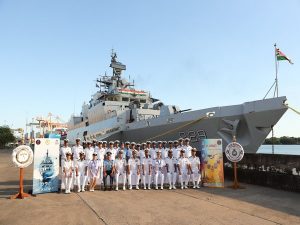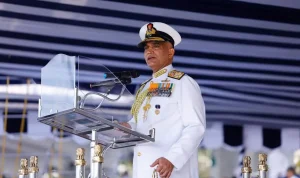Indian Navy Chief Sounds Alarm on Maritime Cyber Threats: “Weaponization of Everything” Poses Existential Risk
In a pointed address that underscores the changing face of warfare, the Indian Navy’s Chief has issued a stark warning: the “weaponization of everything” is now a real and existential threat in the maritime domain. His caution signals that the seas are no longer just a physical battleground but increasingly one dominated by bits and bytes, where a well-launched cyber attack could cripple navies, ports, or national security in ways once thought impossible.
A New Battlefront at Sea
Gone are the days when naval power meant merely steel, guns, and ships. Today, the seas are laced with digital arteries — navigation systems, communication networks, surveillance links, satellite feeds, logistics IT backbones — and all of these are vulnerable. The Navy Chief argues that adversaries won’t need missiles if they can blind a fleet, scramble radar, or paralyze port operations with code. In his view, neglecting maritime cybersecurity is not just reckless — it’s a gambit with stakes as high as national survival.
He described how cyber tools can now act as invisible weapons: attacks on automated systems, spoofing of GPS navigation, jamming of communication channels, and digital infiltration of command and control networks. In effect, “everything” in a navy’s arsenal — from sensor arrays to support infrastructure — can be repurposed or corrupted. This is the “weaponization” he warns of.
Why the Seas Are Especially Vulnerable
The maritime environment presents unique challenges for cyber defense. Ships and offshore platforms operate in isolated, often harsh conditions, reliant on satellite links, long-range communications, and embedded control systems. Physical distance from land-based support complicates patching vulnerabilities or responding to breaches. Moreover, many naval and port systems across the world have legacy software or loosely integrated networks, which make them susceptible to infiltration.


In the Indian context, with vast coastlines, high maritime traffic, strategic choke points and dependence on sea lanes for trade and energy, the vulnerability is magnified. A successful cyber strike on key ports or naval assets could disrupt logistics, commerce, and strategic deterrence. The Chief’s warning is not abstract — it reflects a real and present danger in a world where conflict increasingly shifts into invisible spaces.
The Call for Cooperation, Resilience and Vigilance
The Indian Navy Chief’s appeal goes beyond alarm — it is a call to action. He urged greater inter-service coordination, intelligence sharing, and joint operational planning among maritime, cyber, and defense agencies. The notion is that no single service can counter this threat in isolation; the digital seas demand a unified front.

He also emphasized building resilience into naval systems by adopting “defense in depth” strategies: redundancies, segmentation of networks, hardened cybersecurity protocols, real-time monitoring, and rapid incident response. Training naval personnel not only as sailors or tacticians but also as cyber-aware operators is central to this approach.
International cooperation, too, finds a place in his vision. Threats in the Indian Ocean don’t respect national boundaries — a malware breach in one country’s port system can echo across trade routes. Hence, alliances, joint drills, shared threat intelligence, and harmonized cyber norms are vital parts of any real defense.
Implications for Maritime Strategy
What the Navy Chief’s words suggest is that future naval dominance will depend not just on the number of ships, submarines, or aircraft, but on who controls the digital spectrum. A small tactical advantage in cyber space could translate into grand strategic leverage at sea.
Countries must now think of their maritime posture not only in terms of hardware acquisitions and fleet size but also in cyber readiness, software integrity, and digital resilience. Investments in AI for anomaly detection, quantum communication, secure satellite links, and cyber-hardened naval architecture will become as crucial as surface warships and submarines.
Conclusion
The Indian Navy Chief’s warning about the “weaponization of everything” is a timely reminder that the era of classical sea power is evolving. In an age where cyber and physical realms converge, maritime security depends not only on naval strength but on digital strength. The Chief’s message is clear: nations must act now, or risk being unmoored by unseen, invisible tides of conflict.

